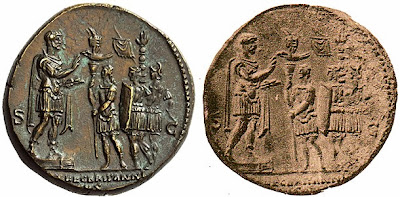Provenance Lost
Ancient coins are the most abundant ancient artifacts that are widely collected, and very few of these coins have a recorded provenance. Some archaeologists interpret this lack of provable provenance as evidence that such coins should be regarded as having been "looted" after 1970, when the UNESCO Convention on the Means of Prohibiting and Preventing the Illicit Import, Export and Transfer of Ownership of Cultural Property was adopted.
Numismatic experts profoundly disagree with that dogmatic perspective, having observed how coin collections are continually being transferred between collectors, through sale to dealers and through auctions. They know that the amount of "new to the trade" material entering the market is only a very small fraction of that which was previously in collections.
These experts also understand that documenting provenance is expensive, and that unless provenance increases the market value of a coin, it is unlikely to be recorded -- unless the coin is illustrated in an auction catalogue. Economic considerations make demands by archaeologists that provenance must be recorded for coins unreasonable and impractical.
Recently, a clear example of the difficulties of tracing provenance for coins surfaced in the case of one of the premier numismatic exhibits at the British Museum -- the Exercitus Britannicus sestertius struck by Hadrian, which in many ways is the most important and evocative Roman coin relating to Britain in existence:
http://www.coinweek.com/featured-news/ancient-coins-107-years-hidden-mystery-hadrian-exercitus-britannicus-revealed/
by Geoffrey Cope
It had been displayed at the British Museum for many years, until in 2012 regulations concerning artifacts and ancient coins that did not have a provenance dating back to before 1970 came into force, and the authorities of the British Museum informed its owner that the coin could not be displayed any longer, because its traceable provenance only went back to 1980.
It was recently discovered that this coin had previously been illustrated in a 1906 auction catalogue, at which time its reverse had various incrustations that were subsequently removed.
This discovery shows how wrong it is to assume that a coin without known provenance prior to 1970 must be a recent find. Any numismatic expert could determine from the appearance of this coin that it was from an old collection.
****************
COMMENTARY
****************
The principal author of this article is the coin's owner, Geoffrey Cope, who with his co-author Dr. Alan Walker conclude the article with an informative discussion of the inherent difficulty of tracing numismatic provenance, and the ease with which a coin's provenance can be lost even though it is among the few specimens considered valuable enough to illustrate in a sale catalogue. Before the 1980s, they also observe, very large numbers of coins were sold at auction without illustration.
Then as now, even larger numbers of coins were (and are) sold at trade shows and by dealers without provenance. This is not due to any intention of disguising their origin, but rather reflects the costs involved in creating and maintaining a record of provenance which collectors are not willing to pay for.
One has only to examine what the archaeo-bloggers have to say about provenance to realize how dogmatic and detached from economic reality their demands are. These fanatics are not likely to modify their perspective because numismatic experts such as Geoffrey Cope and Dr. Alan Walker present convincing evidence that such provenance demands are unreasonable and impractical.
****************




0 Comments:
Post a Comment
<< Home